Intel Core i7 3960X (Sandy Bridge E) Review: Keeping the High End Alive
by Anand Lal Shimpi on November 14, 2011 3:01 AM EST- Posted in
- CPUs
- Intel
- Core i7
- Sandy Bridge
- Sandy Bridge E
Windows 7 Application Performance
3dsmax 9
Today's desktop processors are more than fast enough to do professional level 3D rendering at home. To look at performance under 3dsmax we ran the SPECapc 3dsmax 8 benchmark (only the CPU rendering tests) under 3dsmax 9 SP1. The results reported are the rendering composite scores.
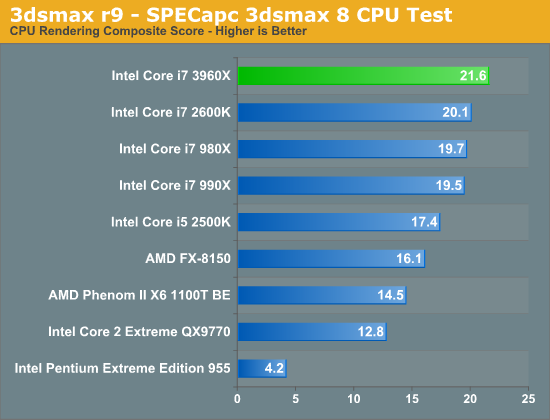
Offline 3D rendering applications make some of the best use of CPU cores, unfortunately our test here doesn't scale all that well. We only see a 7% increase over the 2600K. If we look at a more modern 3D workload however...
Cinebench 11.5
Created by the Cinema 4D folks we have Cinebench, a popular 3D rendering benchmark that gives us both single and multi-threaded 3D rendering results.
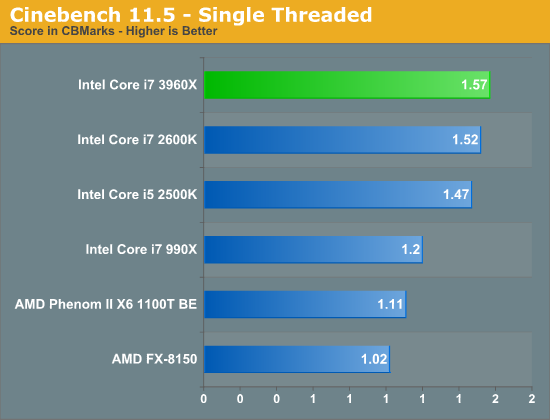
Single threaded performance is marginally better than the 2600K thanks to the 3960X's slightly higher max turbo speed. What's more important than the performance here is the fact that the 3960X is able to properly power gate all idle cores and give a single core full reign of the chip's TDP. Turbo is alive and well in SNB-E, just as it was in Sandy Bridge.
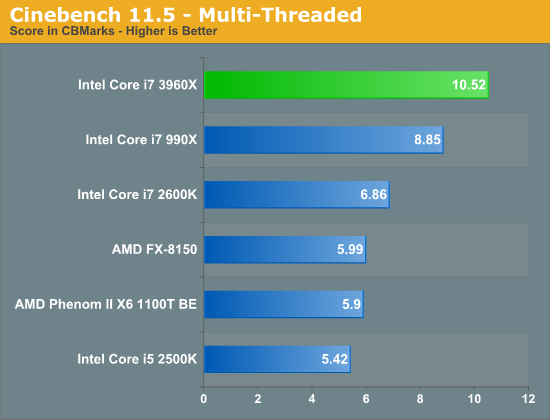
Here the performance gains are staggering. The 3960X is 53% faster than the 2600K and 19% faster than Intel's previous 6-core flagship, the 990X. The Bulldozer comparison is almost unfair, the 3960X is 75% faster (granted it is also multiple times the price of the FX-8150).
7-Zip Benchmark
While Cinebench shows us multithreaded floating point performance, the 7-zip benchmark gives us an indication of multithreaded integer performance:

Here we see huge gains over the 2600K (58%), indicating that the increase in cache size and memory bandwidth help the boost in core count a bit here. The advantage over the 990X is only 7%. This gives us a bit of a preview of what we can expect from SNB-EP Xeon server performance.
PAR2 Benchmark
Par2 is an application used for reconstructing downloaded archives. It can generate parity data from a given archive and later use it to recover the archive
Chuchusoft took the source code of par2cmdline 0.4 and parallelized it using Intel’s Threading Building Blocks 2.1. The result is a version of par2cmdline that can spawn multiple threads to repair par2 archives. For this test we took a 708MB archive, corrupted nearly 60MB of it, and used the multithreaded par2cmdline to recover it. The scores reported are the repair and recover time in seconds.
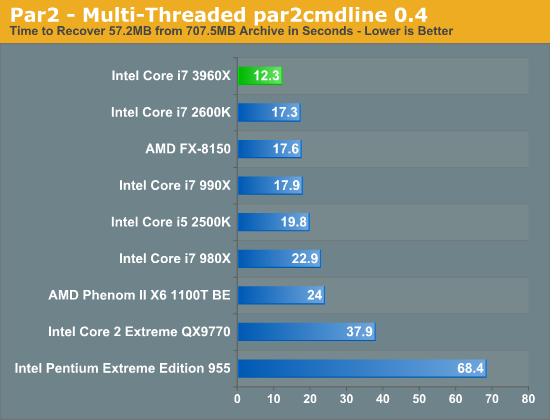
Here we see a 40% increase in performance over the 2600K and FX-8150.
TrueCrypt Benchmark
TrueCrypt is a very popular encryption package that offers full AES-NI support. The application also features a built-in encryption benchmark that we can use to measure CPU performance with:
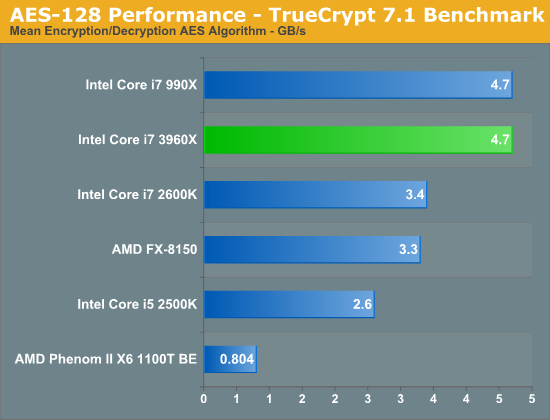
As both the 990X and 3960X have AES-NI support, both are equally capable at cranking through an AES workload. Per core performance doesn't appear to have changed all that much with the move to Sandy Bridge, so here we have a situation where the 3960X is much faster than the 2600K but no faster than the 990X. I suspect these types of scenarios will be fairly rare.
x264 HD 3.03 Benchmark
Graysky's x264 HD test uses x264 to encode a 4Mbps 720p MPEG-2 source. The focus here is on quality rather than speed, thus the benchmark uses a 2-pass encode and reports the average frame rate in each pass.
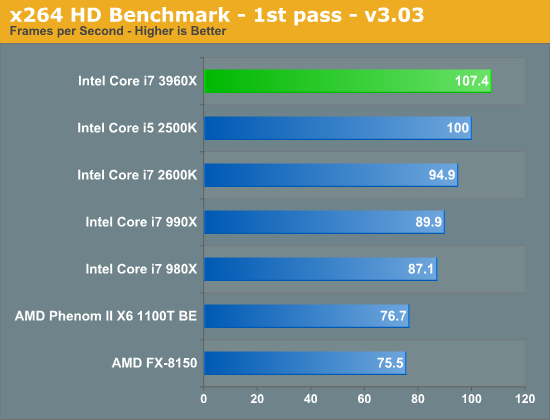
Single threaded performance isn't significantly faster than your run-of-the-mill Sandy Bridge, which means the first x264 HD pass doesn't look all that impressive on SNB-E.
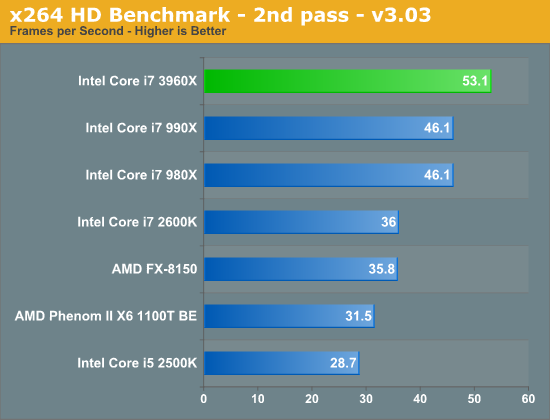
The second pass however stresses all six cores far more readily, resulting in a 47.5% increase in performance over the 2600K. Even compared to the 990X there's a 15% increase in performance.
Adobe Photoshop CS4
To measure performance under Photoshop CS4 we turn to the Retouch Artists’ Speed Test. The test does basic photo editing; there are a couple of color space conversions, many layer creations, color curve adjustment, image and canvas size adjustment, unsharp mask, and finally a gaussian blur performed on the entire image.
The whole process is timed and thanks to the use of Intel's X25-M SSD as our test bed hard drive, performance is far more predictable than back when we used to test on mechanical disks.
Time is reported in seconds and the lower numbers mean better performance. The test is multithreaded and can hit all four cores in a quad-core machine.
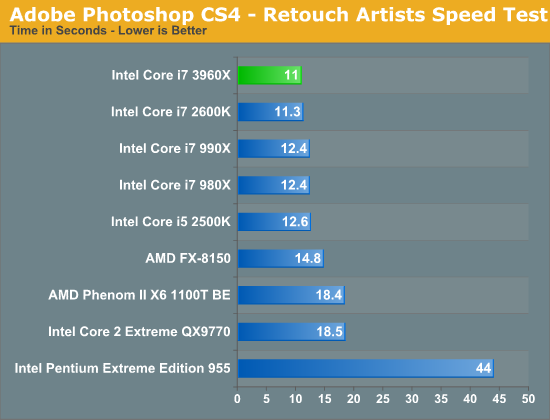
Our Photoshop test is multithreaded but there are only spikes that use more than four cores. That combined with the short duration of the benchmark shows no real advantage to the 3960X over the 2600K. Sandy Bridge E is faster than Intel's old 6-core solution though.
Compile Chromium Test
You guys asked for it and finally I have something I feel is a good software build test. Using Visual Studio 2008 I'm compiling Chromium. It's a pretty huge project that takes over forty minutes to compile from the command line on the Core i3 2100. But the results are repeatable and the compile process will stress all 12 threads at 100% for almost the entire time on a 980X so it works for me.
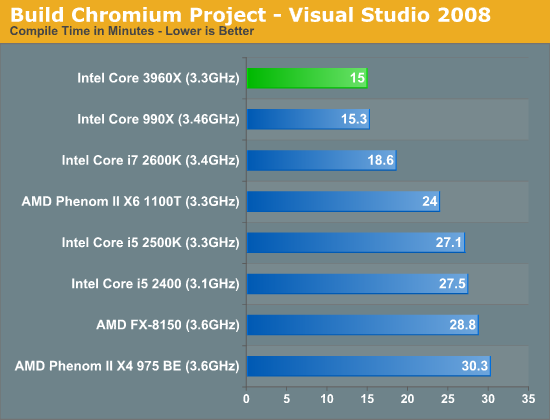
Our compile test is extremely well threaded, which once again does well on the 3960X. The gains aren't as big as what we saw in some of our earlier 3D/transcoding tests, but if you're looking to build the fastest development workstation you'll want a Sandy Bridge E.
Excel Monte Carlo
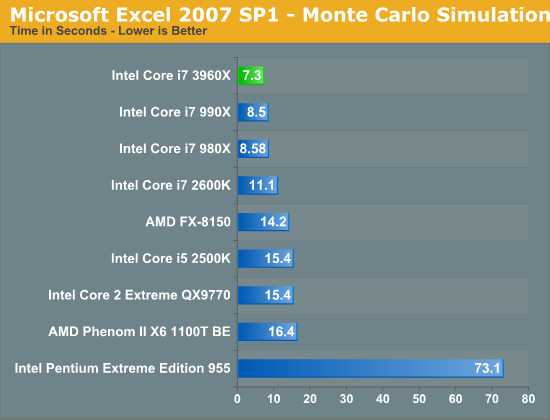
Multithreaded compute does well on SNB-E regardless of the type of application. Excel is multithreaded and if you have a beefy enough workload, you'll see huge gains over the 2600K.










163 Comments
View All Comments
MOBAJOBG - Monday, November 14, 2011 - link
Thanks for performing the analysis and share those information with us.tenks - Monday, November 14, 2011 - link
Am I the only one disappointed with this review?nad, you usually give some amazing insight beyond the simple #s..In this case talking about whats coming up, if this is worth it compared to upcoming stuff in the pipe, or if the rumors about a respin with fixed features, or an allusion to IVy..etc etc etc..?
You've done it in the past. Are you just not allowed to touch on any of this per Intel?
It was a very vanilla review and I dont mean any disrespect, but thats not why I come here for.
Anand Lal Shimpi - Monday, November 14, 2011 - link
I appreciate the criticism. There are a bunch of things I wanted to do that I simply ran out of time for. I added another couple of paragraphs at the end of the conclusion, hopefully directly addressing your concern.To answer you here though: we may see a new chipset offering next year, but IVB-E will probably be at least a year out from now (perhaps even longer). If you need the core count, you will probably be fine on SNB-E while the rest of the world moves to quad-core IVB in the middle of next year.
Take care,
Anand
tenks - Monday, November 14, 2011 - link
Thanks for the response and updating the review..really cool of you. I didn't mean to come off not appreciative, because I am. Just a long time reader who loves the extra insight, reading between the lines and the dot connecting that you do so well...But the more I think about it, maybe it's just the platform itself that I'm disappointed with? Maybe there is no insight really to be had..There is no real "juice" or cool new info we didn't already know about. I guess with all the silence on the platform, even at IDF, I was hoping for that "And one more thing.." feature in SB-E that we didn't know about..Also, forgive me but I have to try..I know you know something..When well the new stepping and 8-core DESKTOP (EE) skus hit?
THizzle7XU - Monday, November 14, 2011 - link
Will there be a video review for this given the time? Your video reviews have been awesome and I really enjoy the conversation type of setting you present. Don't let anyone complain that they are too long :)Also, I was looking forward to this release, but in the last week I've decided to hold off for a while and see what happens with Ivy Bridge. My alternative upgrade ended up being a 512 GB Crucial M4 for my SATA 3 Sandy Bridge laptop and basically had a trickle down effect with moving my Intel 320 SSD to my Core 2 Quad desktop, desktop Intel G2 SSD to PS3, etc. I felt that was a better way to spend $700-$800 at this point for an upgrade that benefited all my devices instead of just my desktop. With the 22 nm process, it there any chance that the mainstream Ivy Bridge will see a 6-core chip? I thought I read some speculation on that...
yankeeDDL - Monday, November 14, 2011 - link
Call me cynical, but reading this review I couldn't help but thinking about AMD Bulldozer's fail.Would we have the 3960X priced $999, if the FX8150 had been able to deliver decent performance (meaning, an 8-core chip beating the i7 2600 by " a little", at $250)?
And the X79 looks just sloppy.
I'm afraid we're starting to see the effect of poor execution by AMD ...
velis - Monday, November 14, 2011 - link
Yep, agree 100%.The chipset released is - as Anand said - a rebrand of existing one. There is absolutely no reason at all to not include SATA 3 and USB 3 all across except if all budget for development was cut.
And the CPU is actually a step back from existing Sandy bridge offerings. No, that was an understatement - it's just a binned existing offering.
Next I'm expecting Ivy delay into late next year at best unless AMD gets its act together.
JlHADJOE - Monday, November 14, 2011 - link
Yes of course it will still be priced at $999.Maybe the 2500k and 2600k will drop in price a bit if Bulldozer had been more competitive, but Intel's Extreme Edition chips have always been pegged at $999.
Lest you forget, it was actually AMD's heydey that drove CPU prices up to the insane levels we are seeing today. Prior to Athlon's dominance, Intel's highest end chip during the Pentium II days, the PII-450 cost around $600.
AMD went on to dominate the chip space after they stuck with their excellent Athlon line, and Intel floundered with the Presshot. Intel was being dominated badly but managed to compete on price. It was AMD who first announced the $1100+ Athlon FX, forcing Intel to re-socket the Gallatin Xeon and sell it as the Pentium 4 Extreme Edition, just undercutting the Athlon FX's price by selling it at $999.
If you look at Intel's track record while they have the performance lead, they have actually been very reasonable with pricing. Recall the $200 Celeron 300A, for instance, which was pretty good at stock, and would overclock into a PII-450 destroyer. Just recently they introduced the brilliant Sandy Bridge, again at about $200-$250, despite the fact that the 2600k destroys their $999 980/990x in gaming.
It was when AMD had the performance lead that the $1000 CPU segment was established,one that has, for better or worse, persisted to this day (despite intel being currently the sole occupant of that segment space).
yankeeDDL - Monday, November 14, 2011 - link
Respectfully, I disagree.First of all, let me be clear: I am not rooting for AMD dominance: I am rooting for "competition" dominance. AMD jacked prices higher when teh Athlon was ridiculizing the P4, and would do so again -I'm sure- if it had the chance.
But it should be recognized that Intel is doing it now. It has "the power" to do so, but that doesn't make it any better for consumers.
Who "started" with the $1000-segment, frankly, is irrelevant: clearly Intel is enjoying it now, so let's focus on that, shall we?
And yes, Intel's top-of the line has always been $999 for a while, however, it is pretty clear that the 3960X is only marginally better than the much more reasonably priced 3930. I don't recall such huge drop in performance/price ratio ever before (I don't have data, but it strikes me as a particularly bad ROI for the 3960).
This said, the X79 is no excuse: re-branding is despicable, no matter who does it.
Also, I think that if the FX8150 was half teh CPU it was supposed to be, instead of the half-ass that it is, Intel would/should have come out with a better improvement over the existing offer, than the 3960 is.
They have delayed SB-E already by a bit, clearly, indicating that not always worked as they planned. If they had to provide an answer to AMD's "compelling" solution, I am sure they would have cranked up SB-E to be a more evident step forward over SB. But given Bulldozer's lack of performance, why bother? They could come out with SB-E "as-is" and not worry about the performance crown, no worry about the ROI, and no worry about cutting features.
just4U - Monday, November 14, 2011 - link
In my opinion, looking at these results Amd's FX8150 isn't so much of a fail after all. Sure it doesn't compare to this beast but they both seem to shine in multi threaded apps and don't seem to be geared up for desktop users. I was expecting to be blown away with the numbers here.... I am not.